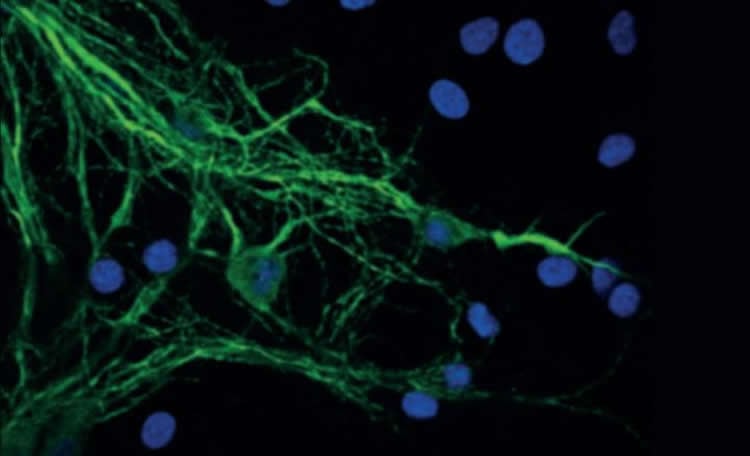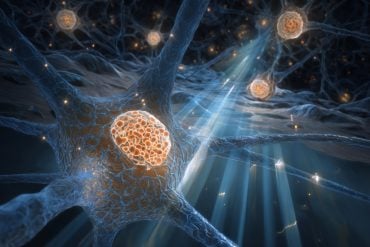Summary: In Parkinson’s disease, alpha synuclein clumps move to and damage mitochondrial proteins, making them less efficient and causing the mitochondrial to burst, leaking out chemicals that tell the cells to die, researchers say.
Source: The Francis Crick Institute.
Detailed brain cell analysis has helped researchers uncover new mechanisms thought to underlie Parkinson’s disease.
The study, published in Nature Communications, adds to our growing understanding of the causes of Parkinson’s and other neurodegenerative diseases, and could influence drug design in the future.
For years, scientists have known that Parkinson’s disease is associated with a build-up of alpha-synuclein protein inside brain cells. But how these protein clumps cause neurons to die was a mystery.
Using a combination of detailed cellular and molecular approaches to compare healthy and clumped forms of alpha-synuclein, a team of scientists at the Francis Crick Institute, UCL, UK Dementia Research Institute at the universities of Cambridge and Edinburgh, New York University and other collaborators have discovered how the protein clumps are toxic to neurons.

They found that clumps of alpha-synuclein moved to and damaged key proteins on the surface of mitochondria – the energy powerhouses of cells – making them less efficient at producing energy. It also triggered a channel on the surface of mitochondria to open, causing them to swell and burst, leaking out chemicals that tell the cell to die.
These findings were replicated in human brain cells, generated from skin cells of patients with a mutation in the alpha-synuclein gene, which causes early-onset Parkinson’s disease. By turning patient skin cells into stem cells, they could chemically guide them into become brain cells that could be studied in the lab. This cutting-edge technique provides a valuable insight into the earliest stages of neurodegeneration – something that brain scans and post-mortem analysis cannot capture.
Sonia Gandhi, Group Leader at the Crick and UCL, and joint senior author of the study said: “Our findings give us huge insight into why protein clumping is so damaging in Parkinson’s, and highlight the need to develop therapies against the toxic form of alpha-synuclein, not the healthy non-clumped form.”
Andrey Abramov, joint senior author of the paper said: “This study was a complex collaboration at the interface of chemistry, biophysics and biology, bringing scientists from different disciplines together to investigate a longstanding problem in Parkinson’s research.”
Source: Greta Keenan – The Francis Crick Institute
Publisher: Organized by NeuroscienceNews.com.
Image Source: NeuroscienceNews.com image is credited to Mathew Horrocks.
Original Research: Open access research for “α-synuclein oligomers interact with ATP synthase and open the permeability transition pore in Parkinson’s disease” by Marthe H. R. Ludtmann, Plamena R. Angelova, Mathew H. Horrocks, Minee L. Choi, Margarida Rodrigues, Artyom Y. Baev, Alexey V. Berezhnov, Zhi Yao, Daniel Little, Blerida Banushi, Afnan Saleh Al-Menhali, Rohan T. Ranasinghe, Daniel R. Whiten, Ratsuda Yapom, Karamjit Singh Dolt, Michael J. Devine, Paul Gissen, Tilo Kunath, Morana Jaganjac, Evgeny V. Pavlov, David Klenerman, Andrey Y. Abramov & Sonia Gandhi in Nature Communications. Published June 12 2018
doi:10.1038/s41467-018-04422-2
[cbtabs][cbtab title=”MLA”]The Francis Crick Institute “Molecular Mechanisms of Parkinson’s Disease Unraveled.” NeuroscienceNews. NeuroscienceNews, 12 June 2018.
<https://neurosciencenews.com/parkinsons-molecular-9323/>.[/cbtab][cbtab title=”APA”]The Francis Crick Institute (2018, June 12). Molecular Mechanisms of Parkinson’s Disease Unraveled. NeuroscienceNews. Retrieved June 12, 2018 from https://neurosciencenews.com/parkinsons-molecular-9323/[/cbtab][cbtab title=”Chicago”]The Francis Crick Institute “Molecular Mechanisms of Parkinson’s Disease Unraveled.” https://neurosciencenews.com/parkinsons-molecular-9323/ (accessed June 12, 2018).[/cbtab][/cbtabs]
Abstract
α-synuclein oligomers interact with ATP synthase and open the permeability transition pore in Parkinson’s disease
Protein aggregation causes α-synuclein to switch from its physiological role to a pathological toxic gain of function. Under physiological conditions, monomeric α-synuclein improves ATP synthase efficiency. Here, we report that aggregation of monomers generates beta sheet-rich oligomers that localise to the mitochondria in close proximity to several mitochondrial proteins including ATP synthase. Oligomeric α-synuclein impairs complex I-dependent respiration. Oligomers induce selective oxidation of the ATP synthase beta subunit and mitochondrial lipid peroxidation. These oxidation events increase the probability of permeability transition pore (PTP) opening, triggering mitochondrial swelling, and ultimately cell death. Notably, inhibition of oligomer-induced oxidation prevents the pathological induction of PTP. Inducible pluripotent stem cells (iPSC)-derived neurons bearing SNCA triplication, generate α-synuclein aggregates that interact with the ATP synthase and induce PTP opening, leading to neuronal death. This study shows how the transition of α-synuclein from its monomeric to oligomeric structure alters its functional consequences in Parkinson’s disease.






